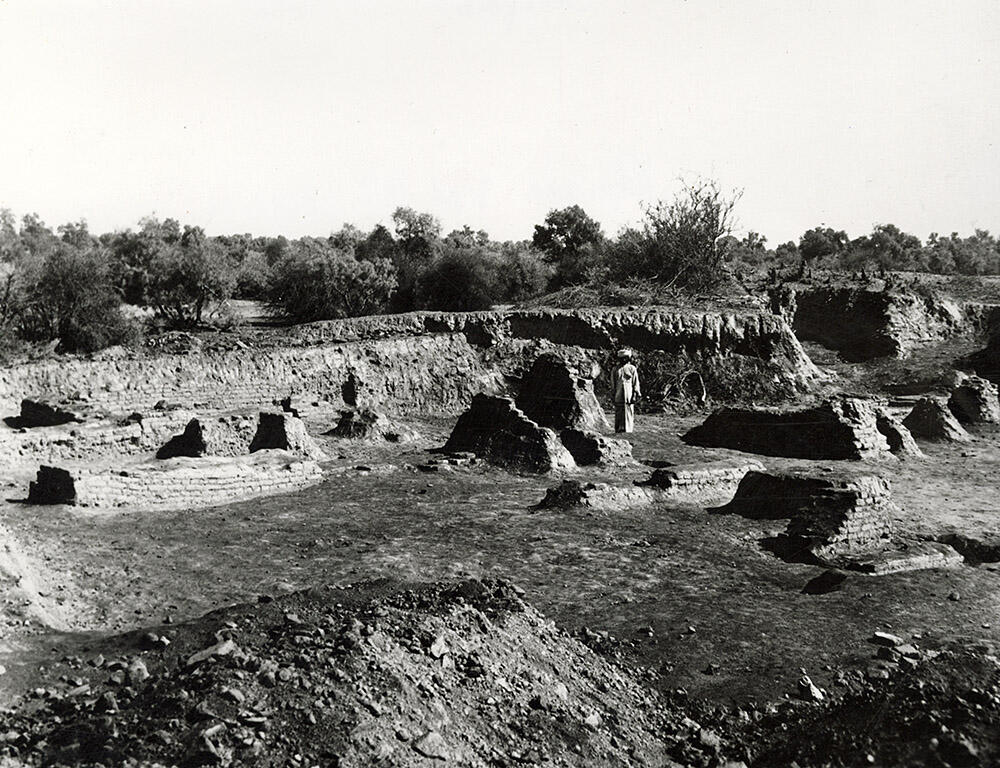"In January 1921, Rai Bahadur Daya Ram Sahni sank in the north-western part of this mound the diagonal Trench A, 16 ft. wide and 500 ft. long from south-east to north-west, starting from the centre of the mound and reaching almost to its north-western end (Pl. I). In the course of his operations here he succeeded in tracing out, in 1923-24, a little more than the southern half of the Eastern Block of the Great Granary and a small part of the Western Block also. (Vats 1940, pg. 17)
Westward along the north-western end of Trench A Mr. Sahni made another extension. It is 90 ft. long from east to west and averages 65 ft. in width. It was excavated to a depth of 4 ft. 6 in. only and revealed several fragmentary walls and broken pavements of the IInd stratum between 2 ft. to 3 ft, 3 in.below the surface, and a few walls of the IIIrd stratum at a depth of 4 ft. 0 in. The mound having fallen here 7 to 10 ft. as compared with the opposite end of the trench, walls of the 1st stratum, except one or two little fragments along the higher northern edge, have altogether disappeared.
Scattered about in this extension and in association with Stratum II were found a unicorn seal (No. A263. Pl, LXXXVI, 21), an excellent pair of heart-shaped bangles (A182) of blue faience with deep indentation on the outside (PL CXXXVIII, 2 and 3), a polished biconical weight (A333) of hornblende (3'65 in. long), half of a plano-convex, rectangular seal (A341, similar to No. 629 in PL XCIX) of faience in which material this shape is rare, and a round terracotta sealing (No. A233, Pl. C, 657). Along the eastern half of the southern edge of this extension were found a squat bi-convex pottery vase (A406, ht. 2-13 in., Pl LXXXII, 9) which contained six assorted miniature vases ranging in height from 0.5 to 0.65 in, (PL CXXXIX, 53-55 and 61-63), and the painted neck of an oval jar (A442) similar in shape and painting to the well preserved jar found by Mr. K. N, Dikshit at Mohenjo-daro.
Parallel to and at a distance of about 20 ft. from the northern edge of this extension is a fairly thick, though fragmentary, wall of the IIIrd stratum which extends for about 80 ft. from east to west. Only two broken party-walls on the south of which one is thicker than the other appear to be connected with it. Between this wall and the southern edge of this extension were found a faience sealing (No. A816, Pl XCV, 397) inscribed with a svastika, a unicorn seal (No.A336,Pl. LXXXVIII, 105), three stone heads including one of banded agate (A307), a small chert weight (A67), fifteen oval tablets of alabaster (A525) ranging in size from 2.25 by 1.9 to 4.2 by 3.1 in. (Pl. CXVII, 52 and 55), and a well executed, jugate terracotta tiger-head (A815) springing from a holed base (PI. LXXIX, 88). Bach of the tigers has two holes on its head, possibly for fixing horns. The conception of this chimera creature is paralleled in the representation of the triple, interlaced tigers on seal 386 from Mohenjo-daro. Close to the alabaster tablets mentioned above was found a well preserved copper blade-axe (A784) with tapering aides. It is 3.75 in. long, 2 in. wide and is inscribed with the figure of a bat on one side.
A large area has been excavated on all sides of tbe Great Granary described above. The whole of it, measuring 230 ft. square together with Trench A and its extension at the north-western end, has now been termed the Granary Area."
- Madho Sarup Vats, 1940. Excavations at Harappa: Being an account of archaeological excavations at Harappa carried out between the years 1920-21 and 1933-34. Volume I - Text; Volume II - 139 Plates., pp. 24-25.
This is the same excavation area as in slide 3, but taken after additional excavation had taken place, particularly in the foreground and in the area to the right of the photo. The fragmentary walls of buildings that had been robbed of bricks are more clear in this photograph.
The faience bangles he describes are illustrated in this slide from the 1921 finds.
- Jonathan Mark Kenoyer, 2023.
[Original caption] Excavations at N.W. end of trench A from SW

